6 August (24 July according to Art. Art.) The Orthodox Church honors the memory of the holy martyr princes Borys and Hleb.
Boris and Hleb (Roman and David at the Baptism) were the sons of Prince Volodymyr the Great of Kyiv. We can learn about the life of the holy brothers and the formation of their general widespread veneration from the "Tales of Bygone Years" and some early hagiographical works. Princes Borys and Hleb became the first canonized saints of the Ukrainian land. The holy brothers did that, which was still new and incomprehensible for pagan Russia, which is used to blood revenge - they did not return evil for evil, even under threat of death, did not seek their personal gain and did not wish to involve the people in internecine strife in order to achieve their own ambitions.
The construction of temples consecrated in their honor and the spread of their iconography in various historical periods are evidence of the people's memory and love for them. We also find images of princes-martyrs among church antiquities in the collection of the Chernihiv Historical Museum named after V.V.. Tarnovsky.
On the bottom board of an old silver plate 1674 Dr.. fixed on the Gospel 1746 Dr.. edition (printing house of the Kyiv-Pechersk Lavra) (inv. No. Al-226)[1] nailed oval middle with engraved full-length images of the holy princes Volodymyr in the center and Boris and Hleb on either side of him. This salary is associated with the name of the prominent Chernihiv Archbishop Lazar Baranovych, which is evidenced by the initials "LBMBPACHNIVS" carved nearby - Lazar Baranovich, by the grace of God, Orthodox Archbishop of Chernihiv, Novgorod and all Severus.
Finely crafted iconographic images adorn the cover of the Gospel (inv. № Al-185)[2], which in 1701 Dr.. presented to the Borys-Hlib Cathedral in Chernigov by the General Clerk of the Zaporizhzhya Army, and later Chernihiv regimental judge Karpo Mokrievich with his wife Anna Kokhanovska. The frame was made in the German city of Augsburg, which was the center of jewelry production in Europe at the time. On the front board on a red background are fixed pictorial finift medallions with the image of Christ the Almighty, twelfth holidays around, martyr princes and other saints.
Images of holy princes can also be found on the vestments of clergymen from the museum collection. So, on the epitrachyla of the middle of the 18th century. of cherry velvet (inv. No. I-1367) the carved composition is a double vertical row of images of four pairs of figures, standing under the arches (from the bottom up): Saints Anthony and Theodosius of Pechersk, Saints Boris and Gleb, Saints Basil the Great and John Chrysostom, Annunciation composition (The Virgin and Archangel Gabriel). Plant motifs are carved between the arches. The hapting is done with gold and silver threads "for attachment". The facial features and hands of the figures are embroidered with silk.
Among the liturgical robes from the collection of the Chernihiv Historical Museum named after VV. Tarnowski's exquisitely embroidered and decorated with precious stones stick of the middle of the XVIII century. (inv. No. I-1971). The composition "Coronation of the Mother of God" is embroidered on a stick from the museum collection. In a medallion from a vegetative ornament it is composed 4 half-figures of saints: above are the righteous Joachim and Anna, below - Saints Boris and Gleb. Iconographic images are embroidered on the four corners of the stick (man, lion, Taurus, Eagle), interpreted as symbols of the apostles-evangelists.
Quilting is made of gold and silver threads, small pearls and corals. All faces are picturesque, halos are lined with river pearls. There are on the stick 26 uncut rubies, some gemstone frames are decorated with delicate enamel. The edges of the liturgical robe are decorated with a brocade fringe.
The sophistication of sewing and stick decor is thought-provoking, that it could belong to one of the Chernihiv archbishops of the XVIII century. Images of Saints Boris and Gleb, in honor of which the city's cathedral was named also indirectly confirms this version.
We can also find images of Saints Boris and Hleb in the museum's collection of old prints. In the collection of sermons of Chernihiv Archbishop Lazar Baranovych "Trumpets for days are intended..." (inv. №. Al-966) 1674 Dr.. edition (printing house of the Kyiv-Pechersk Lavra) an engraving with the image of the saints precedes the speech of the Chernihiv bishop on the day of their memory.
Saints stand on the background of the city, behind them is the cathedral (the Boriso-Hlib Cathedral in Chernihiv is most likely depicted), in their hands they hold crosses and weapons each, from which he accepted death - spear and sword. Above them is the image of Christ with raised blessing hands. At the very top of the engraving is a wavy ribbon on which words from the Apostle Paul's letter to the Philippians are written: "It is given to you about Christ not only to believe in him, but he will suffer for it».
In addition, we find the image of the holy princes on the title engraving of this book among the host of saints.
Their image can also be found on a unique artifact - a letter (inv. No. Al-870) Saint Theodosius Uglytskyi, Archbishop of Chernihiv, namely on a seal printed on paper. The certificate was issued in 1694 Dr.. Archpope Athanasius Zarudsky of Novgorod-Siverskyi. It confirmed his right to the land and forbade anyone to encroach on his property. On the seal of the saint, Christ the Savior is depicted on both sides in priestly vestments with blessing hands. At the bottom of the seal is the coat of arms of Saint Theodosius - a heart pierced by two arrows, symbolizing the two greatest Christian virtues – love for God and love for neighbors.
Старший науковий співробітник музею,
Candidate of Theology Miroslav May-Boroda
[1] Arendar G. Silver plates of the Gospels of the 17th–19th centuries from the collection of the Chernihiv Historical Museum named after V.V.. Tarnovsky. Kyiv, 2021. С. 40.
[2] There only. С. 116.
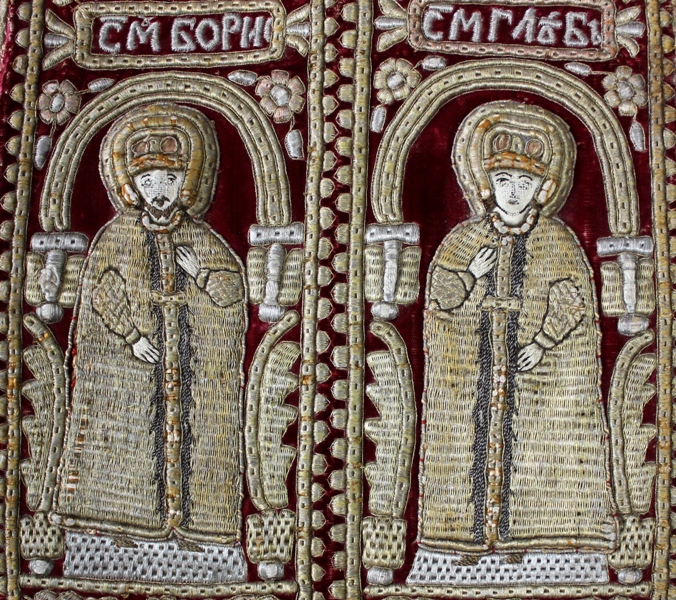
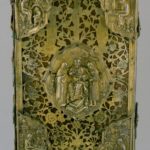
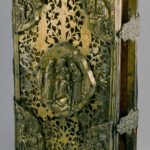
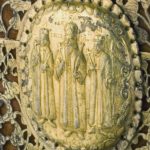
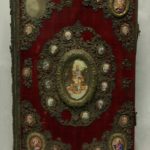
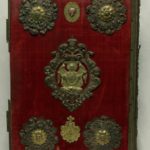
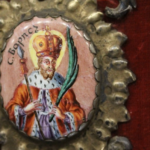















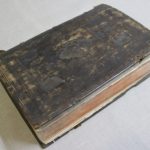



More Stories
Cossack gear and the prices of the Hetmanate day
The Exhibition "Flag - Rely"
Hetman Ivan Mazepa Saber in London Tower